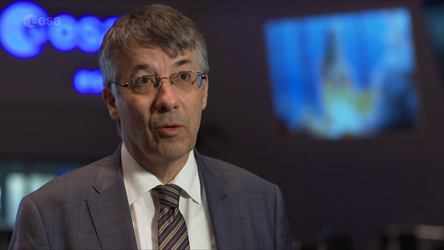Accept all cookies Accept only essential cookies See our Cookie Notice

About ESA
The European Space Agency (ESA) is Europe’s gateway to space. Its mission is to shape the development of Europe’s space capability and ensure that investment in space continues to deliver benefits to the citizens of Europe and the world.
Highlights
ESA - United space in Europe
This is ESA ESA facts Member States & Cooperating States Funding Director General Top management For Member State Delegations European vision European Space Policy ESA & EU Space Councils Responsibility & Sustainability Annual Report Calendar of meetings Corporate newsEstablishments & sites
ESA Headquarters ESA ESTEC ESA ESOC ESA ESRIN ESA EAC ESA ESAC Europe's Spaceport ESA ESEC ESA ECSAT Brussels Office Washington OfficeWorking with ESA
Business with ESA ESA Commercialisation Gateway Law at ESA Careers Cyber resilience at ESA IT at ESA Newsroom Partnerships Merchandising Licence Education Open Space Innovation Platform Integrity and Reporting Administrative Tribunal Health and SafetyMore about ESA
History ESA Historical Archives Exhibitions Publications Art & Culture ESA Merchandise Kids Diversity ESA Brand Centre ESA ChampionsLatest
Space in Member States
Find out more about space activities in our 23 Member States, and understand how ESA works together with their national agencies, institutions and organisations.
Science & Exploration
Exploring our Solar System and unlocking the secrets of the Universe
Go to topicAstronauts
Missions
Juice Euclid Webb Solar Orbiter BepiColombo Gaia ExoMars Cheops Exoplanet missions More missionsActivities
International Space Station Orion service module Gateway Concordia Caves & Pangaea BenefitsLatest
Space Safety
Protecting life and infrastructure on Earth and in orbit
Go to topicAsteroids
Asteroids and Planetary Defence Asteroid danger explained Flyeye telescope: asteroid detection Hera mission: asteroid deflection Near-Earth Object Coordination CentreSpace junk
About space debris Space debris by the numbers Space Environment Report In space refuelling, refurbishing and removingSafety from space
Clean Space ecodesign Zero Debris Technologies Space for Earth Supporting Sustainable DevelopmentLatest
Applications
Using space to benefit citizens and meet future challenges on Earth
Go to topicObserving the Earth
Observing the Earth Future EO Copernicus Meteorology Space for our climate Satellite missionsCommercialisation
ESA Commercialisation Gateway Open Space Innovation Platform Business Incubation ESA Space SolutionsLatest
Enabling & Support
Making space accessible and developing the technologies for the future
Go to topicBuilding missions
Space Engineering and Technology Test centre Laboratories Concurrent Design Facility Preparing for the future Shaping the Future Discovery and Preparation Advanced Concepts TeamSpace transportation
Space Transportation Ariane Vega Space Rider Future space transportation Boost! Europe's Spaceport Launches from Europe's Spaceport from 2012Latest

Tough Love
Thank you for liking
You have already liked this page, you can only like it once!
This Valentine’s Day, look to the skies at night and you’ll see stars twinkling, a glistening Moon and perhaps even an orbiting science lab passing by, the International Space Station.
What you can’t see is the thousands of bits of space debris that circle our planet – remnants of past scientific and technical endeavours, evidence of five decades spent in space.
This last half century has seen a revolution in how we live, work and communicate, with about half the world's population now accessing the internet, a percentage that is rapidly increasing as more and more countries get connected.
This and other vital services, including meteorology, climate research, telecommunications, broadcasting and navigation depend on satellites in space – yet their environment is becoming ever more crowded and unsafe due to space debris.
As of January 2019, the number of debris objects estimated to be in orbit are:
- - 34 000 objects larger than 10 cm in diameter
- - 900 000 objects ranging from from 1 cm to 10 cm in size
- - 128 million objects from 1 mm to 1 cm
Most of these pieces have the potential to damage functioning satellites or even destroy them altogether.
If we continue as we are, without measures to tackle this technological trash, the most useful orbits around Earth will become inhospitable to our critical space infrastructure.
To protect the planet we love, teams at ESA are working to tackle the pollution of space, as part of the Agency's space safety activities.
ESA’s Clean Space initiative is working to prevent the creation of space debris in orbit and to minimise the effect of space missions on our environment, and is planning a future mission to remove a 'piece' of debris from orbit (find out more in the Clean Space blog).
ESA’s Space Debris Office constantly monitors more than 20 000 debris objects in orbit, issuing warnings and guidance to the operators of ESA spacecraft.
Find out more about space debris in our film “Space Debris – A Journey to Earth”.
-
CREDIT
ESA -
LICENCE
CC BY-SA 3.0 IGO or ESA Standard Licence
(content can be used under either licence)

Debris objects - mostly debris - in low Earth orbit…

Space debris

Debris objects in low-Earth orbit (LEO)

On watch for space hazards















 Germany
Germany
 Austria
Austria
 Belgium
Belgium
 Denmark
Denmark
 Spain
Spain
 Estonia
Estonia
 Finland
Finland
 France
France
 Greece
Greece
 Hungary
Hungary
 Ireland
Ireland
 Italy
Italy
 Luxembourg
Luxembourg
 Norway
Norway
 The Netherlands
The Netherlands
 Poland
Poland
 Portugal
Portugal
 Czechia
Czechia
 Romania
Romania
 United Kingdom
United Kingdom
 Slovenia
Slovenia
 Sweden
Sweden
 Switzerland
Switzerland
























